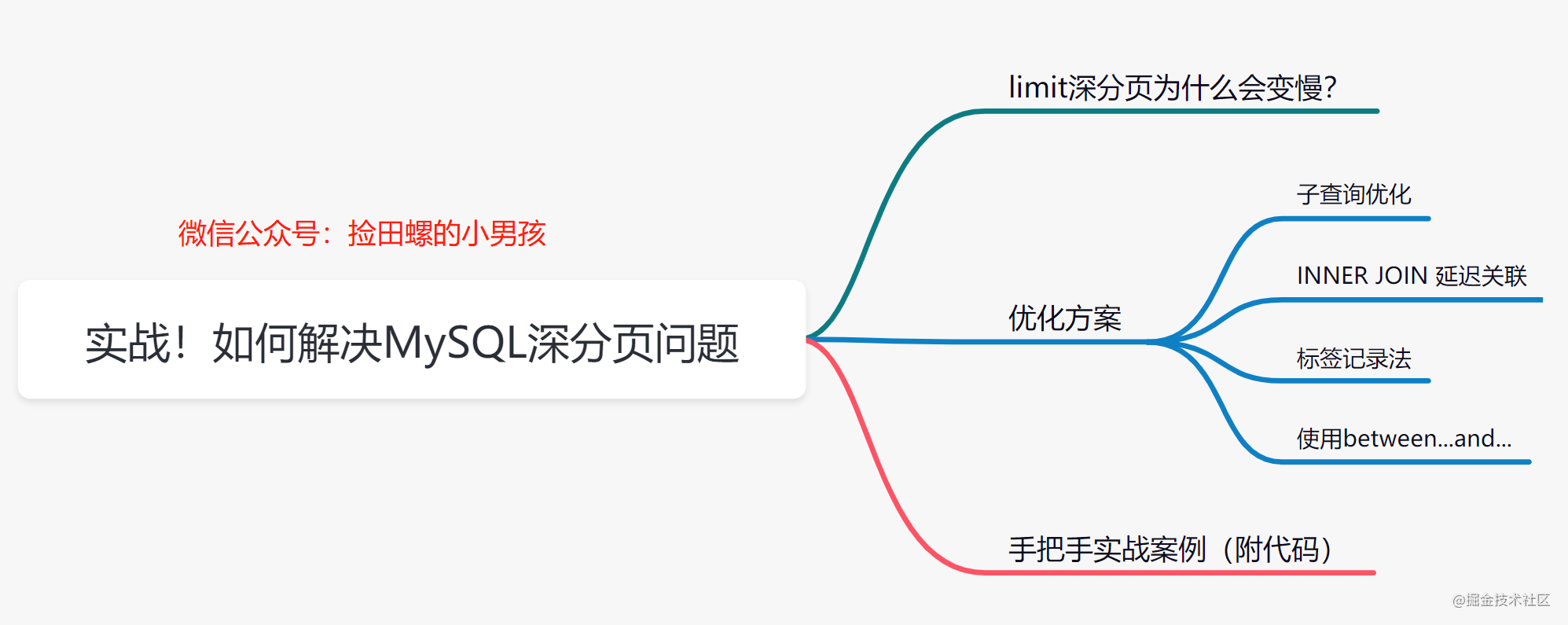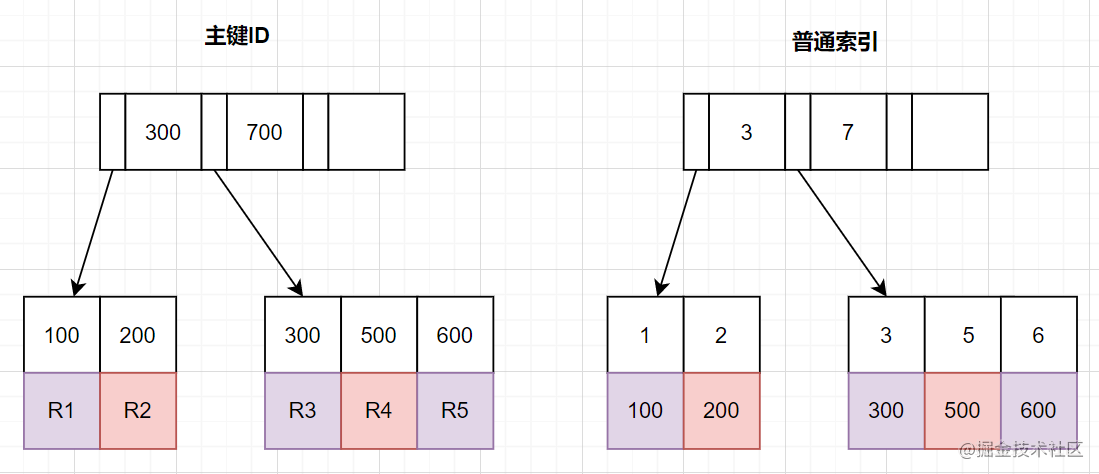前言
我们日常做分页需求时,一般会用limit实现,但是当偏移量特别大的时候,查询效率就变得低下。本文将分4个方案,讨论如何优化mysql百万数据的深分页问题,并附上最近优化生产慢sql的实战案例。

limit深分页为什么会变慢?
先看下表结构哈:
|
1
2
3
4
5
6
7
8
9
10
|
create table account ( id int(11) not null auto_increment comment '主键id', name varchar(255) default null comment '账户名', balance int(11) default null comment '余额', create_time datetime not null comment '创建时间', update_time datetime not null on update current_timestamp comment '更新时间', primary key (id), key idx_name (name), key idx_update_time (update_time) //索引) engine=innodb auto_increment=1570068 default charset=utf8 row_format=redundant comment='账户表'; |
假设深分页的执行sql如下:
|
1
|
select id,name,balance from account where update_time> '2020-09-19' limit 100000,10; |
这个sql的执行时间如下:

执行完需要0.742秒,深分页为什么会变慢呢?如果换成 limit 0,10,只需要0.006秒哦

我们先来看下这个sql的执行流程:
- 通过普通二级索引树idx_update_time,过滤update_time条件,找到满足条件的记录id。
- 通过id,回到主键索引树,找到满足记录的行,然后取出展示的列(回表)
- 扫描满足条件的100010行,然后扔掉前100000行,返回。

sql的执行流程
执行计划如下:

sql变慢原因有两个:
- limit语句会先扫描offset+n行,然后再丢弃掉前offset行,返回后n行数据。也就是说limit 100000,10,就会扫描100010行,而limit 0,10,只扫描10行。
- limit 100000,10 扫描更多的行数,也意味着回表更多的次数。
通过子查询优化
因为以上的sql,回表了100010次,实际上,我们只需要10条数据,也就是我们只需要10次回表其实就够了。因此,我们可以通过减少回表次数来优化。
回顾b+ 树结构
那么,如何减少回表次数呢?我们先来复习下b+树索引结构哈~
innodb中,索引分主键索引(聚簇索引)和二级索引
- 主键索引,叶子节点存放的是整行数据
- 二级索引,叶子节点存放的是主键的值。

把条件转移到主键索引树
如果我们把查询条件,转移回到主键索引树,那就不就可以减少回表次数啦。转移到主键索引树查询的话,查询条件得改为主键id了,之前sql的update_time这些条件咋办呢?抽到子查询那里嘛~
子查询那里怎么抽的呢?因为二级索引叶子节点是有主键id的,所以我们直接根据update_time来查主键id即可,同时我们把 limit 100000的条件,也转移到子查询,完整sql如下:
|
1
|
select id,name,balance from account where id >= (select a.id from account a where a.update_time >= '2020-09-19' limit 100000, 1) limit 10; |
查询效果一样的,执行时间只需要0.038秒!

我们来看下执行计划

由执行计划得知,子查询 table a查询是用到了idx_update_time索引。首先在索引上拿到了聚集索引的主键id,省去了回表操作,然后第二查询直接根据第一个查询的 id往后再去查10个就可以了!

因此,这个方案是可以的~
inner join 延迟关联
延迟关联的优化思路,跟子查询的优化思路其实是一样的:都是把条件转移到主键索引树,然后减少回表。不同点是,延迟关联使用了inner join代替子查询。
优化后的sql如下:
|
1
|
select acct1.id,acct1.name,acct1.balance from account acct1 inner join (select a.id from account a where a.update_time >= '2020-09-19' order by a.update_time limit 100000, 10) as acct2 on acct1.id= acct2.id; |
查询效果也是杠杆的,只需要0.034秒

执行计划如下:

查询思路就是,先通过idx_update_time二级索引树查询到满足条件的主键id,再与原表通过主键id内连接,这样后面直接走了主键索引了,同时也减少了回表。
标签记录法
limit 深分页问题的本质原因就是:偏移量(offset)越大,mysql就会扫描越多的行,然后再抛弃掉。这样就导致查询性能的下降。
其实我们可以采用标签记录法,就是标记一下上次查询到哪一条了,下次再来查的时候,从该条开始往下扫描。就好像看书一样,上次看到哪里了,你就折叠一下或者夹个书签,下次来看的时候,直接就翻到啦。
假设上一次记录到100000,则sql可以修改为:
|
1
|
select id,name,balance from account where id > 100000 order by id limit 10; |
这样的话,后面无论翻多少页,性能都会不错的,因为命中了id索引。但是你,这种方式有局限性:需要一种类似连续自增的字段。
使用between...and...
很多时候,可以将limit查询转换为已知位置的查询,这样mysql通过范围扫描between...and,就能获得到对应的结果。
如果知道边界值为100000,100010后,就可以这样优化:
|
1
|
select id,name,balance from account where id between 100000 and 100010 order by id desc; |
手把手实战案例
我们一起来看一个实战案例哈。假设现在有表结构如下,并且有200万数据.
|
1
2
3
4
5
6
7
8
9
10
11
|
create table account ( id varchar(32) collate utf8_bin not null comment '主键', account_no varchar(64) collate utf8_bin not null default '' comment '账号' amount decimal(20,2) default null comment '金额' type varchar(10) collate utf8_bin default null comment '类型a,b' create_time datetime default null comment '创建时间', update_time datetime default null comment '更新时间', primary key (id), key `idx_account_no` (account_no), key `idx_create_time` (create_time) ) engine=innodb default charset=utf8 collate=utf8_bin comment='账户表' |
业务需求是这样:获取最2021年的a类型账户数据,上报到大数据平台。
一般思路的实现方式
很多伙伴接到这么一个需求,会直接这么实现了:
|
1
2
3
4
5
6
7
8
9
10
11
12
13
14
15
16
17
18
19
20
21
22
23
24
25
26
27
28
29
30
|
//查询上报总数量integer total = accountdao.countaccount();//查询上报总数量对应的sql<select id ='countaccount' resulttype="java.lang.integer"> seelct count(1) from account where create_time >='2021-01-01 00:00:00' and type ='a'</select>//计算页数int pageno = total % pagesize == 0 ? total / pagesize : (total / pagesize + 1);//分页查询,上报for(int i = 0; i < pageno; i++){ list<acctountpo> list = accountdao.listaccountbypage(startrow,pagesize); startrow = (pageno-1)*pagesize; //上报大数据 postbigdata(list);} //分页查询sql(可能存在limit深分页问题,因为account表数据量几百万)<select id ='listaccountbypage' > seelct * from account where create_time >='2021-01-01 00:00:00' and type ='a' limit #{startrow},#{pagesize}</select> |
实战优化方案
以上的实现方案,会存在limit深分页问题,因为account表数据量几百万。那怎么优化呢?
其实可以使用标签记录法,有些伙伴可能会有疑惑,id主键不是连续的呀,真的可以使用标签记录?
当然可以,id不是连续,我们可以通过order by让它连续嘛。优化方案如下:
|
1
2
3
4
5
6
7
8
9
10
11
12
13
14
15
16
17
18
19
20
21
22
23
24
25
26
27
28
29
30
31
32
|
//查询最小idstring lastid = accountdao.queryminid();//查询最大id对应的sql<select id="queryminid" returntype=“java.lang.string”>select min(id) from accountwhere create_time >='2021-01-01 00:00:00'and type ='a'</select>//一页的条数integer pagesize = 100;list<acctountpo> list ;do{ list = listaccountbypage(lastid,pagesize); //标签记录法,记录上次查询过的id lastid = list.get(list,size()-1).getid(); //上报大数据 postbigdata(list);}while(collectionutils.isnotempty(list));<select id ="listaccountbypage"> select * from account where create_time >='2021-01-01 00:00:00' and id > #{lastid} and type ='a' order by id asc limit #{pagesize}</select> |
总结
到此这篇关于mysql深分页问题的文章就介绍到这了,更多相关mysql深分页问题的内容请搜索服务器之家以前的文章或继续浏览下面的相关文章希望大家以后多多支持服务器之家!
原文链接:https://juejin.cn/post/7012016858379321358














